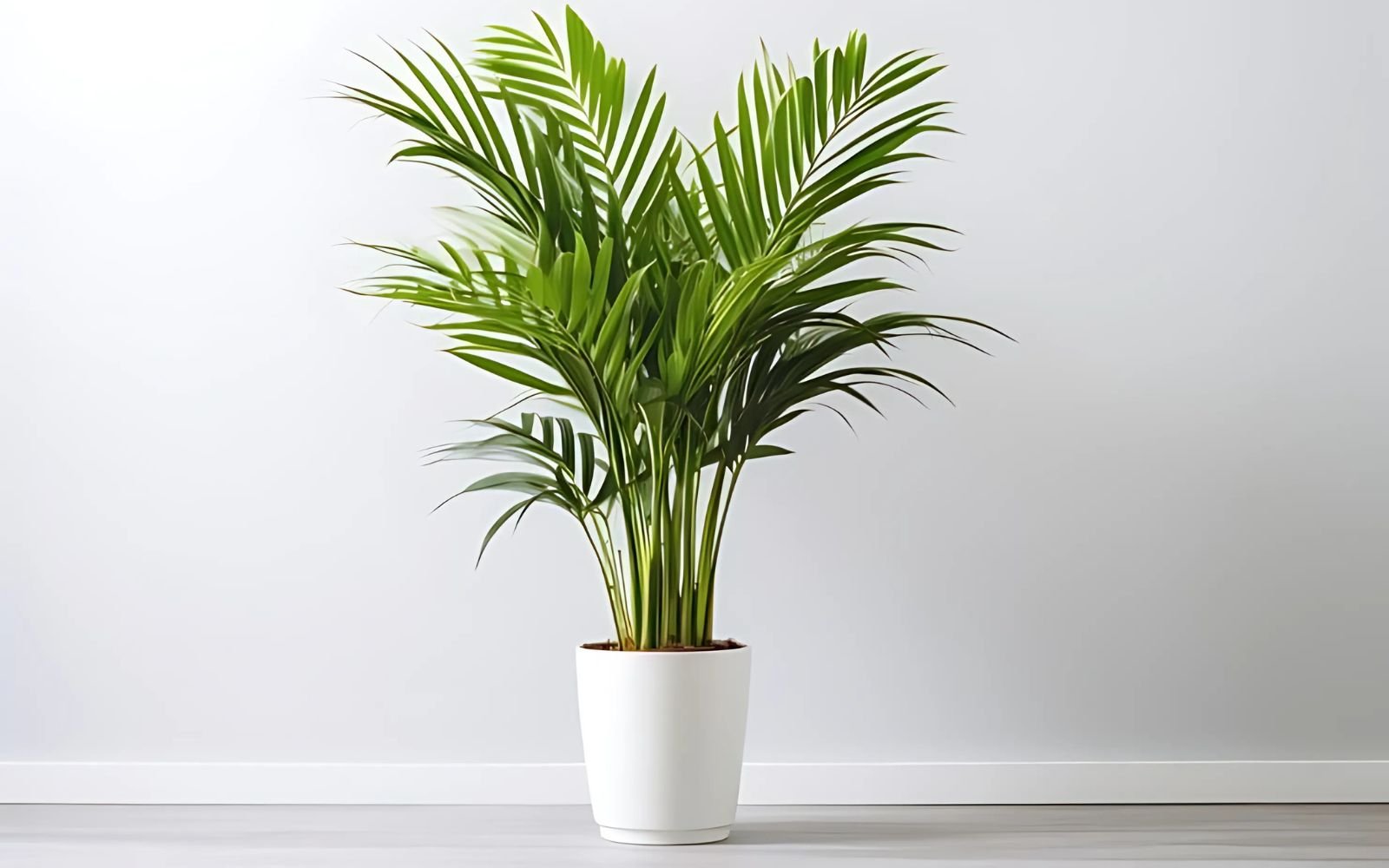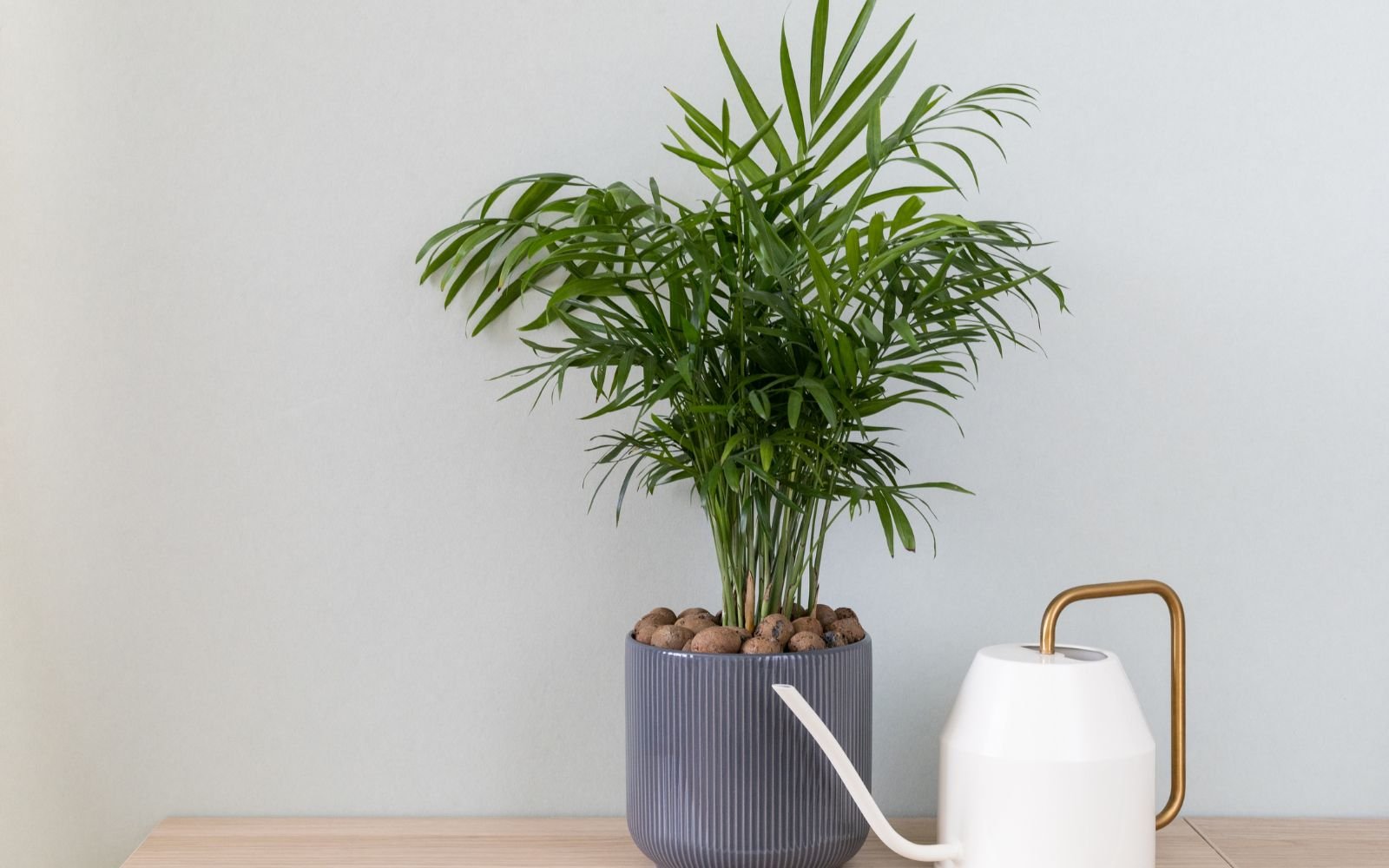Are you looking to bring a touch of the tropics into your home or garden? Indeed, palm trees are the perfect choice! They offer a combination of elegance, lush greenery, and exotic charm that transforms any space into a tranquil oasis. Interestingly, very few know that types of palm trees differ for indoor gardens and outdoor garden spaces. Yes, you heard it right! This is especially important because the growth requirements for both differ a lot. But don’t worry; we are here to help. So, if you are looking for different types of palm trees that suit your indoor and outdoor spaces, you are in the right place. In this post, we will list the best indoor and outdoor palms as well as their growth requirements. Additionally, get some caring tips for healthy plant growth.
Table of Contents
ToggleIndoor Palm Varieties
Indoor palm trees bring a fresh tropical feel to your home and even don’t need much care. Here’s a look at the most popular types to help you pick one that matches your space and style.
1. Areca (Palmypsis lutescens)
First up, we have the Areca Palm, which people also call the Butterfly Palm or Bamboo Palm. This beautiful indoor plant has feathery arching fronds that look quite fancy. Its bright green leaves make your space look better and clean the air, which is why plant lovers like it so much.

- Light Needs: Does well in bright indirect light but can handle lower light levels.
- Watering: Maintain moist soil but don’t over water. It’s better to let soil dry completely before watering.
- Humidity: Prefers high humidity, so mist often to promote growth.
- Temperature: Thrives in 65–75°F (18–24°C).
- Height: Can reach 6–10 feet indoors, making it a standout feature.
- Why it’s worth your money: The Areca Palm’s elegant fronds create a calming atmosphere, making it a great choice for living rooms or offices.
2. Parlor Palm (Chamaedorea elegans)
The Parlor Palm comes next on our list. People love this plant for its slim fine fronds and how easy it is to care for. You can put it in any spot in your house because it grows well even when there’s not much light.

- Light Needs: Likes low to medium light; direct sun can burn its leaves.
- Watering: Keep soil damp but not soaking wet.
- Humidity: Thrives in humid air; spray with water now and then.
- Temperature: Happy in 65–75°F (18–24°C).
- Height: Grows 2–6 feet fitting well in small areas.
- Why it’s so great: This cute palm adds simple style to any room without needing much care making it great for busy plant owners.
3. Kentia Palm (Howea forsteriana)
What’s more, the Kentia Palm stands out as the perfect example of elegance. Its tall, arching fronds curve , and it can handle some neglect. You can put this plant in a bright corner or a dim hallway. Either way, it adds a touch of tropical luxury to your home.

- Light Needs: Likes bright indirect light but handles lower light.
- Watering: Let the top inch of soil dry before you water to stop overwatering.
- Humidity: Does well with a bit of misting now and then.
- Temperature: Does best in 65–75°F (18–24°C).
- Height: Can reach 6–10 feet when grown inside.
- Why You’ll Love It: Its eye-catching fronds and low-maintenance make it a great addition to any room.
4. Majesty Palm (Ravenea rivularis)
Also, the Majesty Palm stands out if you want to create a striking impression. Its rich, feathery fronds give off an air of splendor. This plant does well in bright indirect light.
- Light Needs: Bright indirect light; stay away from harsh sun.
- Watering: Maintain moist soil but make sure it drains well.
- Humidity: Thrives in high humidity; spray often to keep it healthy.
- Temperature: Does best in 65–75°F (18–24°C).
- Height: Can reach 6–10 feet when grown indoors.
- Why Chose It: Its lush fronds bring a grand touch to any room changing even basic spaces into tropical getaways.
5. Ponytail Palm (Beaucarnea recurvata)
Also, even though its name suggests otherwise, the Ponytail Palm isn’t a palm tree—but its unique appeal makes it popular among many. With its swollen base and curving leaves, it stands out as an attractive plant to have in your house.
- Light Needs: Does best in bright indirect light but can handle some direct sun.
- Watering: Wait for the soil to dry out before you water; it can survive long periods without water.
- Humidity: Doesn’t need much; you don’t have to mist it.
- Temperature: Thrives in 60–75°F (16–24°C).
- Height: Can grow up to 3–4 feet when kept indoors.
- Reasons to Plant It: Its eye-catching form and easy care make it ideal if you want a standout plant that doesn’t demand much attention.
Tips to Care for Indoor Palms
Taking good care of your palms, you can make a green tropical paradise inside your home. Here’s some tips to keep them green:
- Avoid Overwatering: Allow the soil to dry a bit between watering sessions to stop root rot.
- Fertilization: Give palms a balanced, water-soluble fertilizer in spring and summer.
- Repotting: Move to a new pot every 2-3 years or when the palm gets too big for its current one.
- Pruning: Cut off dead or yellow fronds to keep the plant looking good and healthy.
5 Outdoor Palm Varieties
When you think about outdoor palm trees, they’re not just plants—they make a statement! Outdoor palms boost your garden’s looks and give it a holiday feel. Check out the following types of palm trees for your outdoor space.
1. Queen Palm (Syagrus romanzoffiana)
First up, the Queen Palm stands out as an outdoor favorite. People love it for its height and graceful, feathery fronds that arch outward. This majestic palm helps create a grand tropical atmosphere in your garden.
- Light Needs: Does best in full sun but can handle some shade.
- Watering: Needs regular water in dry areas.
- Soil Requirements: Likes well-drained acidic soil (Ph 6.2-6.5)
- Height: Can reach up to 50 feet making it a grand addition to big gardens.
- Why You’ll Love It: Its impressive height and full canopy give great shade while adding beauty to any outdoor area.
2. Canary Island Date Palm (Phoenix canariensis)
What’s more, people often call the Canary Island Date Palm the “Jewel of the Palms.” Its thick trunk and crown of bending fronds make it stand out in gardens.
- Light Needs: Needs full sun to grow best.
- Watering: Needs moderate water; handles dry spells well once it’s settled.
- Soil Requirements: Grows in many soil types but likes well-drained soil best.(Ph 6.1-7.8)
- Height: Can grow up to 60 feet tall, great for big gardens.
- Why you’ll Like It: Its strong, eye-catching shape adds a fancy feel to outdoor areas.
3. Windmill Palm (Trachycarpus fortunei)
The Windmill Palm stands out as one of the toughest palm types, which makes it a top pick for colder areas. Its small size and fan-shaped leaves allow it to fit well in many gardens.
- Light Needs: Thrives in full sun or partial shade.
- Watering: Needs regular watering; keep soil from getting soggy.
- Soil Requirements: Likes rich well-draining soil.
- Height: reaches 20–40 feet, fits well in small to medium gardens.
- Why You To Plant: It can handle cold, thus makes it great for many climates.
4. Pygmy Date Palm (Phoenix roebelenii)
If you don’t have much room but want a tropical look, try the Pygmy Date Palm. This compact palm works well on patios, near walkways, or as a standout plant.
- Light Needs: Thrives in full sun or partial shade.
- Watering: Requires steady moisture; keep the soil from drying out.
- Soil Requirements: Grows best in nutrient-rich well-drained soil( pH: 6.0-7.5).
- Height: Grows to a convenient size of 6–12 feet.
- Why it will appeal to you: Its small size and fine fronds make it fit well in any outdoor area.
5. Foxtail Palm (Wodyetia bifurcata)
Last but not least, the Foxtail Palm stands out with its bushy fronds that look like a fox’s tail and its smooth trunk. It fits well in modern gardens that need a special tropical feel.
- Light Needs: Thrives in full sun exposure.
- Watering: Needs regular watering but can handle some dry spells after it’s settled in.
- Soil Requirements: Does best in soil (pH: 5.6-7.8) that drains well and has average nutrients.
- Height: reaches 30–40 feet in height.
- Why it’s perfect for you: Its unique fronds and graceful trunk turn heads and start conversations in any outdoor area.
How To Take Care of an Outdoor Palm Tree?
Now that you’ve chosen the perfect palm tree, it’s essential to know how to care for it. Proper maintenance ensures your palms stay lush and beautiful for years to come.
- Choose the Right Location: Whether it’s an indoor or outdoor palm, ensure they get the right amount of light based on their needs.
- Water Wisely: Overwatering or underwatering can harm palms. Check the soil regularly and adjust your watering schedule accordingly.
- Feed with Fertilizer: Use a palm-specific fertilizer to provide essential nutrients like magnesium and potassium.
- Prune Gently: Trim dead or yellowing fronds, but avoid over pruning, as this can weaken the plant.
- Watch for Pests: Keep an eye out for common palm pests like spider mites and scale insects, and treat them promptly.
- Protect from Cold: For outdoor palms in colder climates, consider wrapping the trunk or moving potted palms indoors during winter.
Wrapping up
By selecting the right palm for your outdoor and indoor space, you can create a lush paradise that complements your home’s style and climate. Whether you’re looking for a towering centerpiece or a compact beauty, there’s a palm tree for every garden. So, the types of palm trees you chose depend on your personal preference.
FAQ
- Do palm trees need a lot of water?
Generally, palm trees prefer well-draining soil and moderate watering. Overwatering can lead to root rot, so it’s important to let the top inch of soil dry out before watering again.
- What types of palm trees can tolerate drought?
Some drought-tolerant types of palm trees include the Mediterranean Fan Palm and the California Fan Palm.
- How fast do different types of palm trees grow?
Growth rates vary widely among types of palm trees. For example, the Pygmy Date Palm grows slowly, while the Queen Palm







